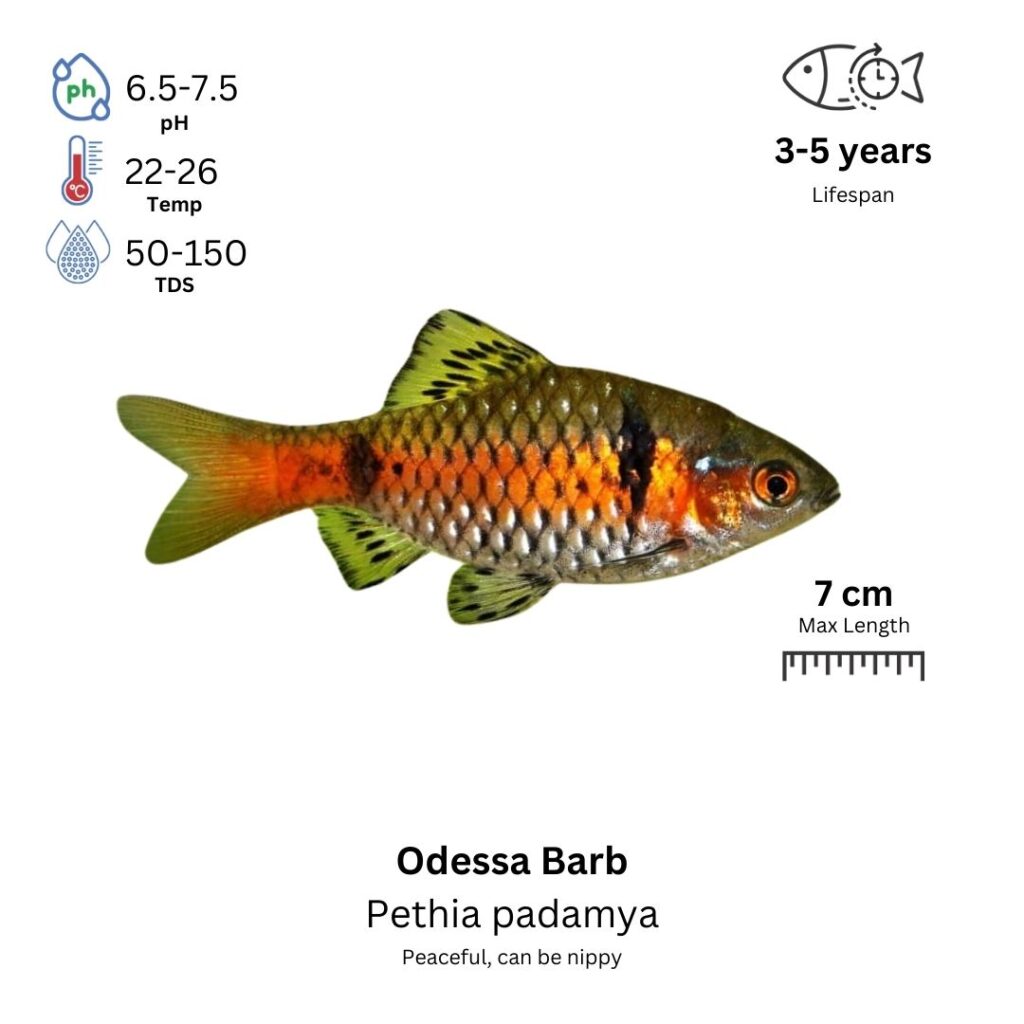Odessa Barb
Pethia padamya

Description
The Odessa Barb is a small, vibrant species of barb that is known for its striking coloration. The body of the Odessa Barb is generally a golden to reddish-orange hue, with darker vertical black stripes running down the body. The males are particularly colorful, exhibiting more intense red and orange shades, especially around the fins and tail. Females are usually more subdued in color, but they still have the characteristic stripes and golden body. Odessa Barbs have a streamlined body and a peaceful nature, making them an excellent addition to community aquariums. They are active swimmers and are often seen darting around the tank in groups, displaying their bright colors.
Habitat Origin
Native to Myanmar (Burma), specifically found in slow-moving rivers and streams with soft, slightly acidic water. They typically inhabit areas with dense vegetation and abundant submerged rocks, which provide hiding spots and grazing opportunities. Odessa Barbs are accustomed to warm, tropical environments, and they thrive in well-oxygenated water.
Aquarium
Ideal Number in Aquarium: At least 6 individuals, as they are schooling fish and feel more secure in groups.
Favorite Food

Odessa Barbs are omnivores and will accept a variety of foods. They can be fed high-quality flake food, micro pellets, live or frozen foods like brine shrimp, bloodworms, and daphnia. They will also graze on algae and small plant matter in the aquarium. A varied diet ensures they stay healthy and maintain their vibrant coloration.
Behavior:
Odessa Barbs are active and social fish that thrive in schools. They are peaceful and generally calm but can become more lively when swimming in a group. They are not fin-nippers like some other barbs, making them suitable tankmates for smaller or more delicate fish. Odessa Barbs are typically found in the middle levels of the tank but will explore all areas of the aquarium, especially when given plenty of hiding spots and decorations. While they are peaceful, males can sometimes show dominance during breeding times, but they rarely display any aggression.
Special Care:
Odessa Barbs are hardy and easy to care for, but they prefer stable water conditions. Regular water changes and good filtration are important to maintain water quality, as they thrive in clean, well-oxygenated environments. Providing plenty of plants, rocks, and other decorations will help mimic their natural habitat and offer hiding spaces. Odessa Barbs are best kept in tanks with peaceful species that have similar water requirements.
Compatibility with Other Fish:
Yes, Odessa Barbs are compatible with a wide range of peaceful species. They can be housed with other small tetras, rasboras, peaceful cichlids, and catfish. They can also coexist with snails and shrimp. It is best to avoid keeping them with aggressive or large fish that may intimidate or prey on them. Their peaceful and social nature makes them ideal tankmates for other community fish that are not too small or delicate.
Breeding Tank Setup
To breed Odessa Barbs successfully, it is best to use a separate breeding tank to ensure optimal conditions and prevent egg predation. A 60-liter (15-gallon) aquarium is sufficient for a breeding pair or a small group, providing enough space for comfortable spawning. These barbs prefer slightly acidic to neutral water with a pH of 6.0–7.5, temperatures between 24°C and 28°C (75°F to 82°F), and soft to moderately hard water (5–12 dGH). Gentle filtration, such as a sponge filter or low-flow internal filter, prevents stress and supports natural spawning behavior. A substrate of fine sand or smooth gravel, along with plants like Java moss, Hornwort, or Anubias, provides suitable surfaces for egg attachment. Moderate lighting with floating plants like duckweed or water sprite creates shaded areas similar to their natural habitats.
Conditioning for Breeding
Conditioning Odessa Barbs for breeding involves providing them with a nutritious, high-protein diet to stimulate reproductive readiness. Feed them high-quality flakes supplemented with live foods such as brine shrimp, daphnia, and bloodworms, alongside frozen options like mysis shrimp and blackworms. Regular small water changes (about 25% weekly) maintain optimal water quality, enhancing fish health and stimulating spawning behaviors by mimicking natural environmental conditions.
Spawning Process
Odessa Barbs exhibit egg-scattering spawning behaviors, with males energetically courting females through vivid coloration and chasing displays. During spawning, females scatter sticky eggs onto substrates or plants, and males fertilize them immediately afterward. Each spawning can produce between 50 to 200 eggs. It is crucial to promptly remove adults after spawning, as Odessa Barbs tend to consume their own eggs, jeopardizing egg survival if left unattended.
Fry Care
Eggs hatch typically within 24 to 48 hours, dependent on temperature. Newly hatched fry initially remain attached to spawning surfaces, relying on yolk sacs for nourishment. Once free-swimming, begin feeding them infusoria, microscopic algae, or liquid fry foods. After a few days, transition to baby brine shrimp or other microscopic live foods. As the fry develop further, offer finely crushed flakes or shrimp pellets. Maintaining excellent water quality through daily 10–15% water changes, monitoring stable temperatures (24°C–28°C), and regular checks of ammonia, nitrite, and nitrate levels significantly improves fry survival and health.
Important Breeding Notes
Odessa Barbs reach sexual maturity at about 6 to 12 months old; waiting until full maturity ensures greater breeding success. Males are distinguishable by their smaller, slimmer body and vibrant red, orange, or golden colors, particularly noticeable during courtship. Females are typically larger, rounder, and paler, especially when gravid. To ensure stress-free breeding conditions, maintain calm tank environments, provide ample hiding spots, and avoid aggressive tankmates or overcrowding, as these factors can negatively impact spawning outcomes and egg viability.
